Business
No Lakhs in Lac
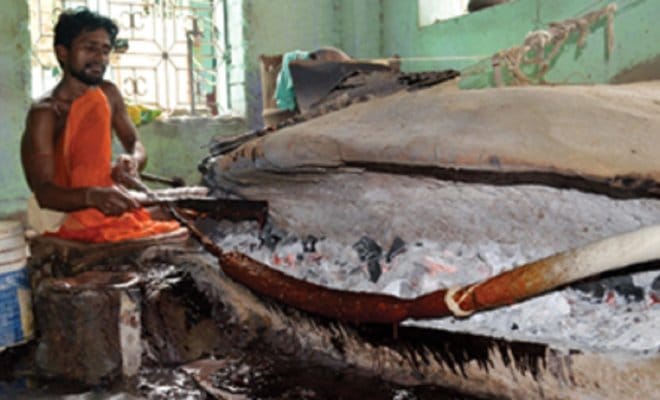
Lac cultivation has a long history in India and has been the source of livelihood for several thousands of people, both directly and indirectly.
Haridas Rai is a worried man these days. For the past three decades, he has eked out his living by cultivating lac (a resinous substance secreted as a protective covering by the lac insect) in his village Charida, in the Purulia district of West Bengal, some 350 kms from Kolkata. He funded the education of his three children from the income he derived from selling sticklac.
The falling prices of sticklac, however, are endangering his business. The sexagenarian now runs a small grocery shop in the village. “The lac cultivation has been the ancestral profession of the villagers. My forefathers made good profits. The business was good even a few years ago, but the falling prices of the sticklac have made it difficult to stick with the trade anymore. I have opened a grocery shop to keep the kitchen fire burning,” says a visibly disappointed Rai.
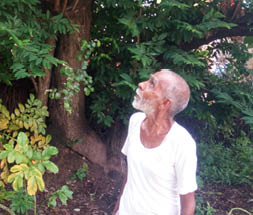
Haridas Rai: “The falling prices of the sticklac have made it difficult to stick with the trade anymore.” Photo: Monirul Islam Mullick
Rai also blames climatic conditions among the reasons farmers are quitting lac cultivation: “The produce has been dwindling with each passing year. The climatic condition of the district that was once considered favorable for lac cultivation is no longer suitable. The temperature is changing fast. The harmful pesticides could also be the reason for poor crop.”
Lac, once the economic backbone of Purulia district, has suffered from declining prices — which fell from a peak of Rs 1000 per kg in 2012 to just Rs 100 in 2015 — coupled with the lack of serious intervention by successive governments and exploitation of farmers by middle-men and sellers. The country’s annual lac production has dwindled from 42,000 tons in the 1950s to 17,000 tons in 2014. During the same period, exports declined from 29,000 tons to 6,600 tons.
Lac cultivation has a long history in India and has been the source of livelihood for several thousands of people, both directly and indirectly. Jharkhand accounts for almost half the country’s lac crop, followed by Madhya Pradesh,. Chhattisgarh, Maharashtra, Odisha, West Bengal and Assam. However, West Bengal dominates in the processing of lac, accounting for 44 percent of lac products, with Purila hosting half the 183 processing units in the country.
The word “lac” is believed to have been derived from the Sanskrit word “Laksha,” meaning a hundred thousand, and is suggestive of the large number of insects involved in its production.
The Atharva Veda describes the insect and its host plant (food plant) — Palas (Lakshataru). According to legend in the Mahabharata, the Kauravas built the highly inflammable Lakhagriha or Jadugriha (Lac House) in an attempt to physically liquidate the Pandavas by setting the lac palace on fire.
The 16th Century Ain-i-Akbari records the use of pigmented lac varnishes for painting screens. Lac was also known to ancient Greek and Romans. In more recent times, the lac business was encouraged during British rule in the 1900s to uplift India’s tribal population.
By the beginning of 20th century, migrants from Mirzapur came to Purulia to establish lac manufacturing factories for processing local raw material at lower overhead costs. Within a decade, 55 factories were established at Balarampur and Jhalda. The cultivators are still mostly tribals.
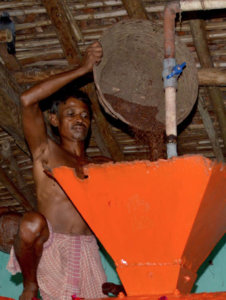
Photo: Monirul Islam Mullick
After Thailand, India is the largest producer of lac with over 115 processing units spread in the five districts of Purulia, Bankura, Midnapur, Murshidabad and Malda in West Bengal alone. The Balrampur block in Purulia is the hub of lac production with nearly 100 units, processing almost 6,600 tons of lac. Nearly, 20,000 people are dependent on the trade.
The cultivation begins when a farmer gets a stick (broodlac) that contains eggs ready to hatch and ties it to a tree to be infested. “Thousands of lac insects colonize the branches of the host trees such as kusumi (kusum), or rangeeni (palas, ber) and secrete the resinous pigment. The coated branches of the host trees are cut and harvested as sticklac,” says Rai.
“The harvested sticklac is crushed and sieved to remove impurities. The sieved material is then repeatedly washed to remove insect parts and other soluble material. The resulting product is known as seedlac, which still contains 3-5 percent impurities and is processed into shellac by heat treatment or solvent extraction.”
Lac finds major usage in the chemical, perfume, pharmaceutical, electrical, bangles and food industries. It is even used on costume jewelry and in traditional folk medicines, such as an anti-obesity drug.
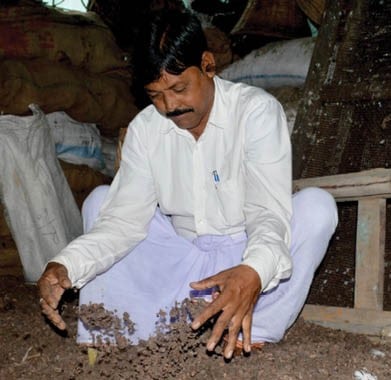
Ranjit Majhi: “The exporters have monopolies.” Photo: Monirul Islam Mullick
If the farmers complain low prices discourage them from cultivating lac, processing unit owners are equally unhappy. Ranjit Majhi, who runs a processing unit in Balrampur, says that profits are low because of the increasing cost of labor and lack of serious efforts by the government to support the industry: “We have to engage labors for making seedlac out of the sticklac supplied by the farmers. The prices of the raw material are not stable, because the government is yet to fix any minimum support price for lac. This makes it difficult to sell the product to the exporters who always want to buy goods at minimum prices. The exporters have monopolies and tactically buy the shellac and other items at lower prices from us and then export them to foreign countries by making huge profits.”
“The banks refuse to give us interest, because the processing unit owners are defaulters as they fail to return the loan on time. The government should make arrangements to provide us loans at cheaper rates.”
He adds that massive deforestation in Bengal has also led to a steep rise in the price of the raw material and traders have to depend on Jharkhand for the supply of sticklac.
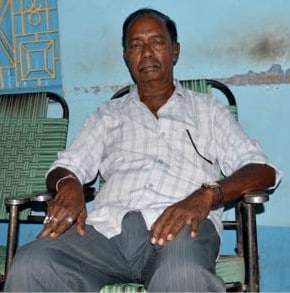
Subhash Chander Dey: “There are some nefarious brokers, who act as middlemen between the exporters and their clients abroad.” Photo: Monirul Islam Mullick
Subhas Chandra Dey, president of the Balrampur Retail Lac Small Scale Cottage Industry adds that automation of the industry has put pressure on the labor market: “Lac is a labor intensive industry involving large number of people, but the processing units are now installing machines, which have been robbing several people of their work and turning them jobless. The handmade products can survive for three years, while those made from machine have a lifespan of just six months, but the exporters still opt for the latter as the production is greater at a shorter time.”
Dey, who has been into the business for over four decade, blames brokers for hurting the income of farmers and processing unit owners: “There are some nefarious brokers, who act as middlemen between the exporters and their clients abroad. They promise exporters and clients of providing them goods at cheaper rates in return of a commission. They start circulating fake rumors about the bumper crop of lac to dampen the enthusiasm of farmers and processing unit owners, convincing them to sell their products at lower rates to exporters. They make double profits from both of them while those on the lower rung suffer. We have often complained to the government officers to stop the malpractices, but to no avail. An MSP (minimum support price) should be immediately fixed.”
Apart from shellac, seedlac buttons, aleuritic acid (a major ingredient in shellac) and ambrettolide are some of the common products exported to the United States, China, Pakistan, Germany, Australia, Bangladesh and other countries. The United States is the biggest customer of lac products from Purulia, buying 25 percent of the total production.
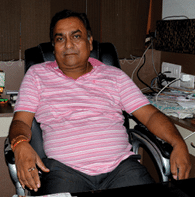
Lac exporter Anup Kumar Agarwala, “We are often cast as villains for exploiting the processing unit owners, which is completely baseless.” Photo: Monirul Islam Mullick
Exporters blame the fluctuation in raw material prices for the instability in the market. Anup Kumar Agarwala, a lac exporter and committee member of Shellac and Forest Products Export Promotion Council (SHEFEXIL), says: “We are often cast as villains for exploiting the processing unit owners, which is completely baseless. We decide the rate of procurement months in advance and have to pay to the seller at the same rate, despite the drop in rates at the international level. Our clients sitting abroad pay us on the basis of current prices and often we end up facing loses by giving more to the processing unit owners. Nobody looks into our plight.”
The West Bengal government has decided to set-up a Rs 4 crore Special Purpose Vehicle in Balrampur to encourage the industry. “The government has developed a lac cluster in Purulia. A Common Facility Centre is coming up at Balrampur that the Micro, Small and Medium Enterprises (MSME) Department is building with all required plant and machinery. We are providing skill upgradation, technology support, marketing linkage etc,” said Rajiva Sinha, additional chief secretary, MSME department, West Bengal government.
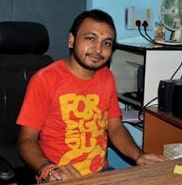
Deepak Banga. Photo: Monirul Islam Mullick
Government plans aim to increase the domestic turnover from Rs 270 crore to Rs 400 crore and exports from Rs 80 crore to Rs 200 crore. Unofficial figures, however, suggest that India exported Rs 300 crore of lac products in 2016-17, of which Purulia contributed Rs 250 crore.
“We have to look for new markets for survival, as lac is also facing serious competition from synthetic resin which is being increasingly used nowadays. Lac-culture not only checks environmental degradation, but also conserves associated fauna and flora for posterity,” says Deepak Banka, a young exporter.
